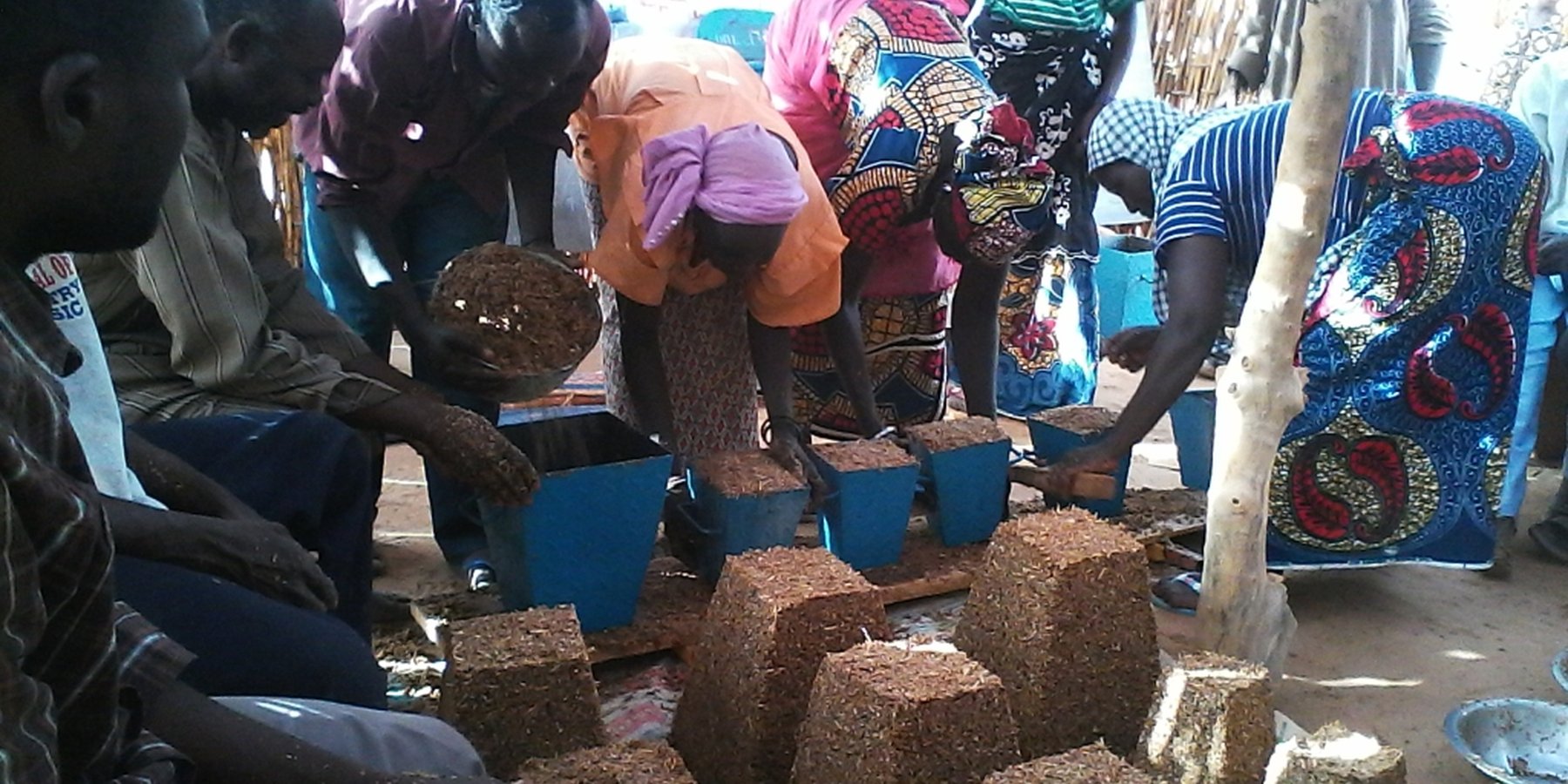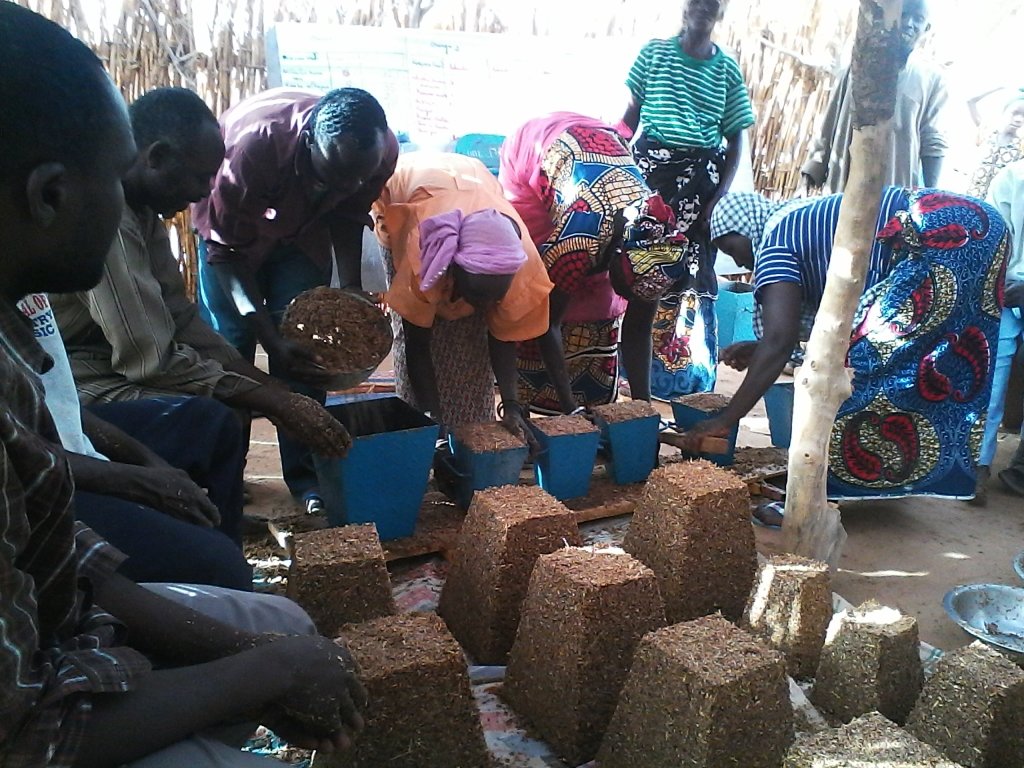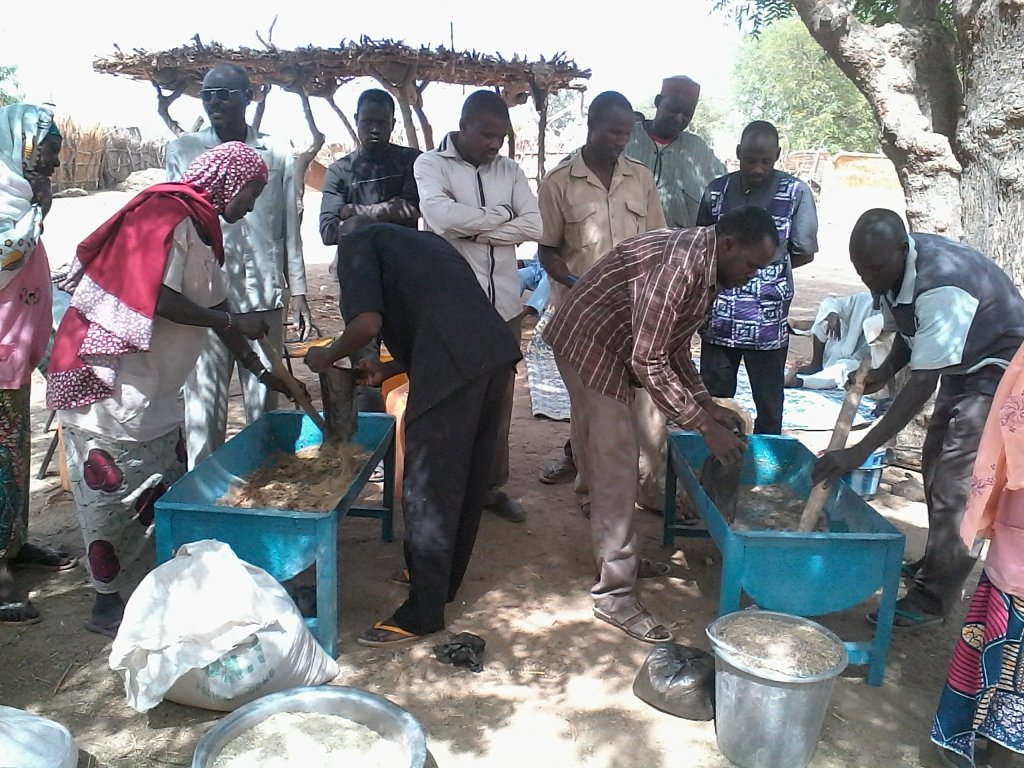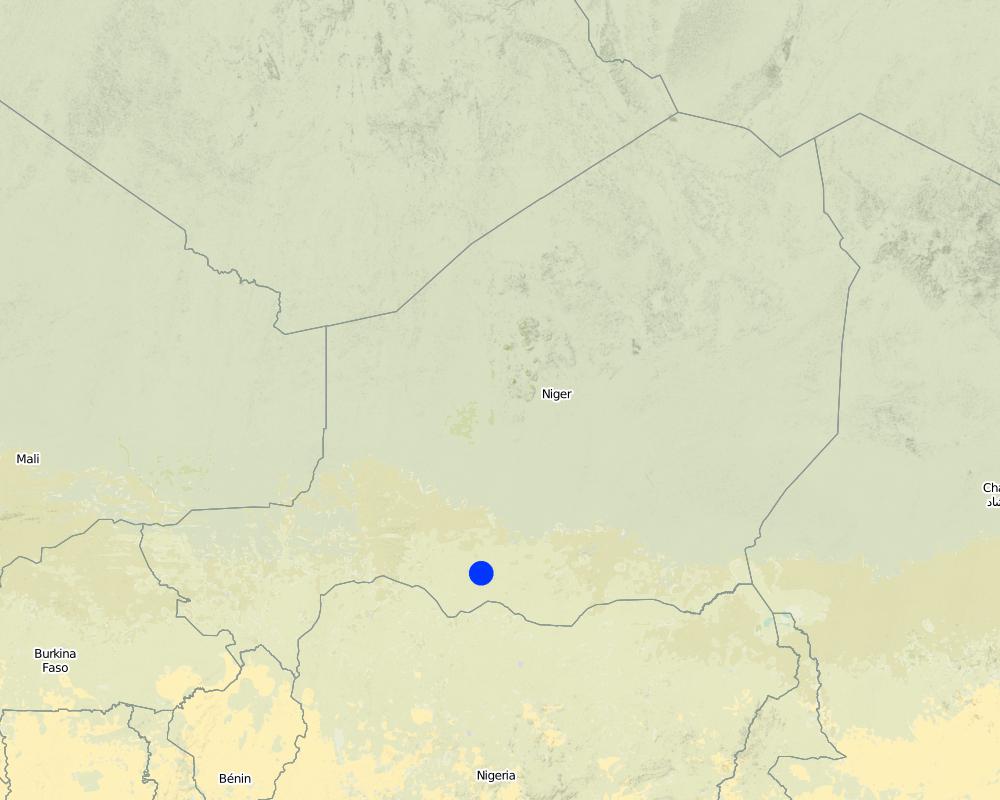Bloc Multi-Nutritionnel Densifié (BMND) [Niger]
- Creation:
- Update:
- Compiler: Judith Macchi
- Editors: Abdourazak Bawa, Christine Lottje
- Reviewers: Alexandra Gavilano, David Beritault
Lassar Dabbobi
technologies_700 - Niger
View sections
Expand all Collapse all1. معلومات عامة
1.2 Contact details of resource persons and institutions involved in the assessment and documentation of the Technology
Key resource person(s)
SLM specialist:
Abdourazak Bawa
Name of project which facilitated the documentation/ evaluation of the Technology (if relevant)
Book project: where people and their land are safer - A Compendium of Good Practices in Disaster Risk Reduction (DRR) (where people and their land are safer)Name of the institution(s) which facilitated the documentation/ evaluation of the Technology (if relevant)
HEKS (Hilfswerk der Evangelischen Kirchen Schweiz) (HEKS (Hilfswerk der Evangelischen Kirchen Schweiz)) - Switzerland1.3 Conditions regarding the use of data documented through WOCAT
The compiler and key resource person(s) accept the conditions regarding the use of data documented through WOCAT:
نعم
1.4 Declaration on sustainability of the described Technology
Is the Technology described here problematic with regard to land degradation, so that it cannot be declared a sustainable land management technology?
لا
1.5 Reference to Questionnaire(s) on SLM Approaches (documented using WOCAT)
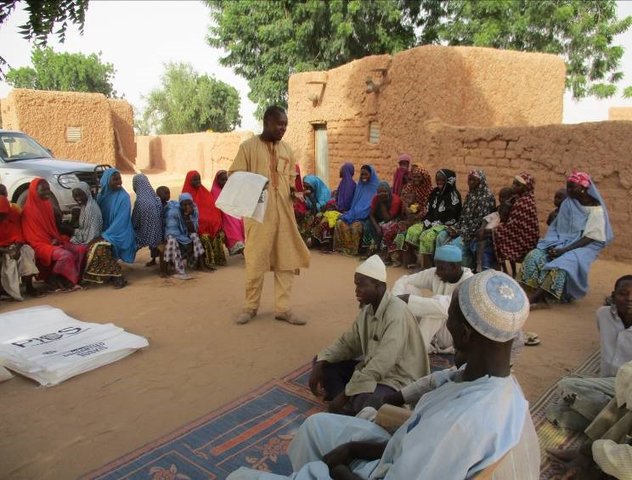
Formation et sensibilisation à l'utilisation de techniques agricoles … [Niger]
Cette approche consiste à vulgariser des techniques agricoles améliorées permettant d'augmenter les productions agricoles. Des producteurs démonstrateurs sont formés et des journées de démonstration sont organisées afin de sensibiliser les autres producteurs à l’utilisation de ces techniques améliorées.
- Compiler: Judith Macchi
2. Description of the SLM Technology
2.1 Short description of the Technology
Definition of the Technology:
Le Bloc Multi-Nutritionnel Densifié (BMND) est une alternative pour l'alimentation des animaux en toute saison. C'est un concentré d'éléments nutritifs préparés à partir de résidus culturaux (tiges, gousses, ...).
2.2 Detailed description of the Technology
Description:
L’élevage est la deuxième activité principale économique au Niger après l’agriculture. Ce secteur contribue de manière soutenue à la sécurité alimentaire en procurant des revenus substantiels aux ménages pastoraux. Malheureusement la dépendance de l’élevage vis-à-vis des ressources naturelles est exacerbée par les récurrentes sécheresses et la dégradation des espaces pastoraux qui accentuent de plus en plus la vulnérabilité des ménages pastoraux. Le bilan fourrager annuel (conditionné par la pluviométrie) est régulièrement déficitaire fragilisant ainsi la sécurité alimentaire des bétails. Même si les animaux ne consomment que 30% de la biomasse sèche, cet apport est insuffisant du point de vue qualitatif. Aussi, les besoins en matière azotée digestible (MAD) nécessaire à la croissance et à la production de lait, ainsi qu’en vitamine A et E ne sont pas couverts. Le phosphore est également un élément essentiel au métabolisme qui doit être apporté en quantité suffisante car la carence de ces éléments dans la ration compromet la survie du bétail d’où la nécessité de trouver des compléments alimentaires qui peuvent permettre de relever le niveau qualitatif de l’alimentation bétail.
Face à ces déficits fourragers assez critiques et récurrents au Niger, la FAO en partenariat avec l’Institut National de la Recherche Agronomique du Niger (INRAN) a initié et testé la technique de fabrication des blocs multi-nutritionnels densifiés (BMND). Des sous-produits agricoles tels que les tiges de mil, de sorgho, de maïs ou la paille de riz sont broyés et mélangés avec des micro nutriments (phosphore, sel), vitamines et liants (gomme arabique, ciment) sont compactés de manière à être grignotés par les animaux herbivores.
Le projet d’appui à la sécurité alimentaire par intensification agro écologique dans le département de Mayahi, réalisé par SahelBio et finance par HEKS/EPER (Swiss Church Aid) a appuyé la mise en place des unités de fabrication des blocs multi nutritionnels. Les unités de production des blocs sont au niveau des villages et sont gérées par les comités villageois. Les BMND sont produits en format de brique pyramidale ou adapté aux besoins du ménage et les principaux équipements pour les produire sont les broyeurs, les récipients de mixture, les moules, les balances, et les petits outillages aratoires. Les blocs sont vendus localement ou au niveau des marchés et constituent donc une source de revenu pour les unités.
Les blocs constituent une alternative pour la complémentation alimentaire des animaux pendant la période de soudure ou en année de déficit fourrager critique. Les blocs permettent ainsi une augmentation de la production laitière et en viande et la dépendance vis-à-vis des aliments importés se diminué. Outre les avantages pour les animaux, la technologie a la particularité de valoriser les résidus des cultures en encourageant les populations à adopter des comportements pour préserver la couverture végétale (cloison manuelle, stockage de la tige, lutte contre les mauvaises herbes, etc.).
2.3 Photos of the Technology
2.5 Country/ region/ locations where the Technology has been applied and which are covered by this assessment
بلد:
Niger
Region/ State/ Province:
Maradi
Further specification of location:
Mayahi
Specify the spread of the Technology:
- evenly spread over an area
If precise area is not known, indicate approximate area covered:
- 10-100 km2
Comments:
La technologie est appliquée dans 2 autres villages du même département
La technologie est destinée aux éleveurs qui sont pour la plupart des nomades
Map
×2.6 Date of implementation
Indicate year of implementation:
2014
2.7 Introduction of the Technology
Specify how the Technology was introduced:
- through projects/ external interventions
Comments (type of project, etc.):
La technologie est introduite par un projet de développement en concertation avec les producteurs
3. Classification of the SLM Technology
3.1 Main purpose(s) of the Technology
- improve production
- adapt to climate change/ extremes and its impacts
- create beneficial economic impact
- Atténuer la crise alimentaire des bétails et améliorer la production, la productivité des herbivores
3.2 Current land use type(s) where the Technology is applied

الأراضي الزراعية
- Annual cropping
Annual cropping - Specify crops:
- seed crops - sesame, poppy, mustard, other
- oilseed crops - groundnuts
- cereals - millet
- cereals - sorghum
- oseille (cf. Rumex)
Number of growing seasons per year:
- 1

أراضي الرعي
Extensive grazing:
- Semi-nomadic pastoralism
Intensive grazing/ fodder production:
- Cut-and-carry/ zero grazing
Animal type:
- cattle - non-dairy beef
- goats
- mules and asses
- sheep
Comments:
Principales cultures (vivrières et commerciales): Mil, sorgho, arachide, sésame, oseille
Principales espèces animales et principaux produits: Caprins, ovins, bovins, asins
3.4 Water supply
Water supply for the land on which the Technology is applied:
- rainfed
Comments:
La plupart des ingrédients (tiges, gousses, fruits...) sont récoltés après la saison des pluies
3.5 SLM group to which the Technology belongs
- pastoralism and grazing land management
- integrated crop-livestock management
- improved plant varieties/ animal breeds
3.6 SLM measures comprising the Technology

vegetative measures
- V3: Clearing of vegetation

other measures
Comments:
Cette technologie permet de valoriser les résidus agricoles en réduisant les pertes
3.7 Main types of land degradation addressed by the Technology

chemical soil deterioration
- Cn: fertility decline and reduced organic matter content (not caused by erosion)
Comments:
Les animaux permettent la fertilisation des sols à travers la fumure
3.8 Prevention, reduction, or restoration of land degradation
Specify the goal of the Technology with regard to land degradation:
- reduce land degradation
Comments:
La technologie vise à apporter une alimentation de qualité aux animaux et ceux-ci contribuent à la fertiisation des sols à travers la fumure.
4. Technical specifications, implementation activities, inputs, and costs
4.1 Technical drawing of the Technology
Technical specifications (related to technical drawing):
Le BMND est distribué aux animaux dans des mangeoires à l'état granulé ou concassé. La capacité d'ingestion du bloc par les ruminants de 1.5 à 2 kg pour les petits ruminants adultes (caprins, ovins) et de 7 à 10 kg pour un bovin adulte.
4.2 General information regarding the calculation of inputs and costs
Specify how costs and inputs were calculated:
- per Technology unit
Specify unit:
par kilogramme de BMND
other/ national currency (specify):
Franc CFA
If relevant, indicate exchange rate from USD to local currency (e.g. 1 USD = 79.9 Brazilian Real): 1 USD =:
550,0
Indicate average wage cost of hired labour per day:
1000 F CFA
4.3 Establishment activities
| Activity | Timing (season) | |
|---|---|---|
| 1. | Broyage des tiges | De decembre a mai |
| 2. | Mesure des quantites d'intrants | De decembre a mai |
| 3. | Melange des intrants dans un bac | De decembre a mai |
| 4. | Moulage des blocs | De decembre a mai |
| 5. | Séchage des blocs | De decembre a mai |
| 6. | Vente | De decembre a mai |
4.4 Costs and inputs needed for establishment
| Specify input | Unit | Quantity | Costs per Unit | Total costs per input | % of costs borne by land users | |
|---|---|---|---|---|---|---|
| Labour | Production blocs | HJ | 4,0 | 1000,0 | 4000,0 | 100,0 |
| Equipment | Broyeur | 1,0 | 700,0 | 700,0 | ||
| Equipment | Seau | 4,0 | 300,0 | 1200,0 | ||
| Equipment | Bac | 2,0 | 800,0 | 1600,0 | ||
| Equipment | Moule | 1,0 | 400,0 | 400,0 | ||
| Equipment | Gazoil | litre | 1,0 | 400,0 | 400,0 | |
| Equipment | Huile moteur | litre | 1,0 | 300,0 | 300,0 | |
| Equipment | Natte | unite | 1,0 | 50,0 | 50,0 | |
| Plant material | Tiges mil ou sorgho | kg | 3,0 | 200,0 | 600,0 | 100,0 |
| Plant material | Fane niebe | kg | 4,0 | 200,0 | 800,0 | 100,0 |
| Plant material | son | kg | 4,0 | 200,0 | 800,0 | 100,0 |
| Plant material | sel | kg | 1,0 | 175,0 | 175,0 | 100,0 |
| Plant material | Gousse Acacia | kg | 1,0 | 150,0 | 150,0 | 100,0 |
| Plant material | Gousse Kalgo | kg | 1,0 | 150,0 | 150,0 | 100,0 |
| Plant material | Ciment | kg | 1,0 | 125,0 | 125,0 | 100,0 |
| Plant material | Eau | litre | 150,0 | 2,0 | 300,0 | 93,0 |
| Total costs for establishment of the Technology | 11750,0 | |||||
| Total costs for establishment of the Technology in USD | 21,36 | |||||
If land user bore less than 100% of costs, indicate who covered the remaining costs:
Le projet a finance les equipements
Comments:
Ce cout est necssaire a la fabrication de 20 kg de BMND
4.5 Maintenance/ recurrent activities
| Activity | Timing/ frequency | |
|---|---|---|
| 1. | Broyage des tiges | De decembre a mai |
| 2. | Mesure des quantites d'intrants | De decembre a mai |
| 3. | Confection des blocs | De decembre a mai |
| 4. | Melange des intrants dans un bac | De decembre a mai |
| 5. | Moulage des blocs | De decembre a mai |
| 6. | Séchage des blocs | De decembre a mai |
| 7. | Vente | De decembre a mai |
4.6 Costs and inputs needed for maintenance/ recurrent activities (per year)
| Specify input | Unit | Quantity | Costs per Unit | Total costs per input | % of costs borne by land users | |
|---|---|---|---|---|---|---|
| Labour | Production blocs | HJ | 4,0 | 1000,0 | 4000,0 | 100,0 |
| Equipment | Gazoil | litre | 1,0 | 400,0 | 400,0 | 100,0 |
| Plant material | Tiges mil ou sorgho | kg | 3,0 | 200,0 | 600,0 | 100,0 |
| Plant material | Fane niebe | kg | 4,0 | 200,0 | 800,0 | 100,0 |
| Plant material | Son | kg | 4,0 | 200,0 | 800,0 | 100,0 |
| Plant material | Sel | kg | 1,0 | 175,0 | 175,0 | 100,0 |
| Plant material | Gousse acacia | kg | 1,0 | 150,0 | 150,0 | 100,0 |
| Plant material | Gousse kalgo | kg | 1,0 | 150,0 | 150,0 | 100,0 |
| Plant material | Ciment | kg | 1,0 | 125,0 | 125,0 | 100,0 |
| Plant material | Eau | litre | 150,0 | 2,0 | 300,0 | 100,0 |
| Total costs for maintenance of the Technology | 7500,0 | |||||
| Total costs for maintenance of the Technology in USD | 13,64 | |||||
Comments:
Le cout annuel dépend de niveau de production
4.7 Most important factors affecting the costs
Describe the most determinate factors affecting the costs:
Ingrédients, carburant
5. Natural and human environment
5.1 Climate
Annual rainfall
- < 250 mm
- 251-500 mm
- 501-750 mm
- 751-1,000 mm
- 1,001-1,500 mm
- 1,501-2,000 mm
- 2,001-3,000 mm
- 3,001-4,000 mm
- > 4,000 mm
Specify average annual rainfall (if known), in mm:
250,00
Specifications/ comments on rainfall:
Saison des pluies de juillet à septembre
Indicate the name of the reference meteorological station considered:
Mayahi
Agro-climatic zone
- semi-arid
5.2 Topography
Slopes on average:
- flat (0-2%)
- gentle (3-5%)
- moderate (6-10%)
- rolling (11-15%)
- hilly (16-30%)
- steep (31-60%)
- very steep (>60%)
Landforms:
- plateau/plains
- ridges
- mountain slopes
- hill slopes
- footslopes
- valley floors
Altitudinal zone:
- 0-100 m a.s.l.
- 101-500 m a.s.l.
- 501-1,000 m a.s.l.
- 1,001-1,500 m a.s.l.
- 1,501-2,000 m a.s.l.
- 2,001-2,500 m a.s.l.
- 2,501-3,000 m a.s.l.
- 3,001-4,000 m a.s.l.
- > 4,000 m a.s.l.
Indicate if the Technology is specifically applied in:
- not relevant
5.3 Soils
Soil depth on average:
- very shallow (0-20 cm)
- shallow (21-50 cm)
- moderately deep (51-80 cm)
- deep (81-120 cm)
- very deep (> 120 cm)
Soil texture (topsoil):
- coarse/ light (sandy)
Soil texture (> 20 cm below surface):
- coarse/ light (sandy)
Topsoil organic matter:
- low (<1%)
5.4 Water availability and quality
Ground water table:
5-50 m
Availability of surface water:
poor/ none
Water quality (untreated):
poor drinking water (treatment required)
Is water salinity a problem?
لا
Is flooding of the area occurring?
لا
5.5 Biodiversity
Species diversity:
- low
Habitat diversity:
- low
5.6 Characteristics of land users applying the Technology
Sedentary or nomadic:
- Sedentary
Market orientation of production system:
- mixed (subsistence/ commercial)
Off-farm income:
- less than 10% of all income
Relative level of wealth:
- very poor
Individuals or groups:
- individual/ household
Level of mechanization:
- manual work
Gender:
- women
- men
Age of land users:
- youth
- middle-aged
Indicate other relevant characteristics of the land users:
Majoritairement analphabète
5.7 Average area of land used by land users applying the Technology
- < 0.5 ha
- 0.5-1 ha
- 1-2 ha
- 2-5 ha
- 5-15 ha
- 15-50 ha
- 50-100 ha
- 100-500 ha
- 500-1,000 ha
- 1,000-10,000 ha
- > 10,000 ha
Is this considered small-, medium- or large-scale (referring to local context)?
- medium-scale
5.8 Land ownership, land use rights, and water use rights
Land ownership:
- individual, not titled
Land use rights:
- individual
Water use rights:
- communal (organized)
Comments:
L'accès à la terre se fait par héritage, achat ou gage
5.9 Access to services and infrastructure
health:
- poor
- moderate
- good
education:
- poor
- moderate
- good
technical assistance:
- poor
- moderate
- good
employment (e.g. off-farm):
- poor
- moderate
- good
markets:
- poor
- moderate
- good
energy:
- poor
- moderate
- good
roads and transport:
- poor
- moderate
- good
drinking water and sanitation:
- poor
- moderate
- good
financial services:
- poor
- moderate
- good
6. Impacts and concluding statements
6.1 On-site impacts the Technology has shown
Socio-economic impacts
Production
fodder production
fodder quality
animal production
Income and costs
diversity of income sources
Socio-cultural impacts
food security/ self-sufficiency
SLM/ land degradation knowledge
situation of socially and economically disadvantaged groups
Ecological impacts
Climate and disaster risk reduction
drought impacts
6.3 Exposure and sensitivity of the Technology to gradual climate change and climate-related extremes/ disasters (as perceived by land users)
Gradual climate change
Gradual climate change
| Season | increase or decrease | How does the Technology cope with it? | |
|---|---|---|---|
| seasonal temperature | dry season | increase | very well |
| other gradual climate change | variabilité de la pluie (augmentation des précipitations extrêmes, anomalies entre les saisons) | increase | very well |
Climate-related extremes (disasters)
Climatological disasters
| How does the Technology cope with it? | |
|---|---|
| drought | very well |
6.4 Cost-benefit analysis
How do the benefits compare with the establishment costs (from land users’ perspective)?
Short-term returns:
positive
Long-term returns:
very positive
How do the benefits compare with the maintenance/ recurrent costs (from land users' perspective)?
Short-term returns:
positive
Long-term returns:
positive
6.5 Adoption of the Technology
- 11-50%
Of all those who have adopted the Technology, how many did so spontaneously, i.e. without receiving any material incentives/ payments?
- 0-10%
Comments:
La mise en œuvre de la technologie nécessite des moyens énormes comme les broyeurs, chose qui n'est pas simple surtout en milieu rural ou les moyens de subsistance font parfois défaut
6.6 التكيف
Has the Technology been modified recently to adapt to changing conditions?
لا
6.7 Strengths/ advantages/ opportunities of the Technology
| Strengths/ advantages/ opportunities in the land user’s view |
|---|
|
Augmentation de la production animale (multiplication, lait, viande...); Les animaux ont plus de valeur; Cette technologie permet de générer des revenus |
| Strengths/ advantages/ opportunities in the compiler’s or other key resource person’s view |
|---|
|
Transfert de compétence; Lutte contre l'insécurité alimentaire à travers un apport alimentaire qualitatif; Amélioration du niveau de vie des producteurs. |
6.8 Weaknesses/ disadvantages/ risks of the Technology and ways of overcoming them
| Weaknesses/ disadvantages/ risks in the land user’s view | How can they be overcome? |
|---|---|
|
La mévente; La grande sensibilité des BMND aux moisissures |
Mise en place d'un mécanisme de mise en marché; Séchage optimal des produits |
| Weaknesses/ disadvantages/ risks in the compiler’s or other key resource person’s view | How can they be overcome? |
|---|---|
| Faible production; | Maîtrise de techniques commerciales et bonne couverture des marchés locaux |
7. References and links
7.1 Methods/ sources of information
- field visits, field surveys
10
- interviews with land users
10
- interviews with SLM specialists/ experts
2
- compilation from reports and other existing documentation
5
When were the data compiled (in the field)?
12/10/2016
7.3 Links to relevant online information
Title/ description:
Booster la production agricole pour prévenir les crises alimentaires
URL:
http://www.fao.org/fileadmin/user_upload/emergencies/docs/Niger_ERCU_Bulletin_1.pdf
Title/ description:
Niger: Blocs multi nutritionnels densifiés pour bétails
URL:
http://www.waapp-ppaao.org/sites/default/files/fiche_bmn_2.pdf
Title/ description:
LA TECHNOLOGIE DES BLOCS MULTI-NUTRITIONNELS AU NIGER
URL:
https://www.youtube.com/watch?v=MH7qfQnFuYE
Links and modules
Expand all Collapse allLinks

Formation et sensibilisation à l'utilisation de techniques agricoles … [Niger]
Cette approche consiste à vulgariser des techniques agricoles améliorées permettant d'augmenter les productions agricoles. Des producteurs démonstrateurs sont formés et des journées de démonstration sont organisées afin de sensibiliser les autres producteurs à l’utilisation de ces techniques améliorées.
- Compiler: Judith Macchi
Modules
No modules


